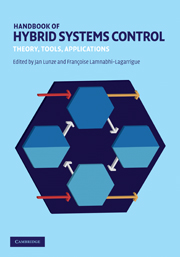Book contents
- Frontmatter
- Contents
- List of contributors
- Preface
- Notation
- Part I Theory
- 1 Introduction to hybrid systems
- 2 Survey of modeling, analysis, and control of hybrid systems
- 3 Hybrid automata
- 4 Switched and piecewise affine systems
- 5 Further switched systems
- 6 Hybrid systems: quantization and abstraction
- 7 Stochastic hybrid systems
- Part II Tools
- Part III Applications
- References
- Index
2 - Survey of modeling, analysis, and control of hybrid systems
from Part I - Theory
Published online by Cambridge University Press: 21 February 2011
- Frontmatter
- Contents
- List of contributors
- Preface
- Notation
- Part I Theory
- 1 Introduction to hybrid systems
- 2 Survey of modeling, analysis, and control of hybrid systems
- 3 Hybrid automata
- 4 Switched and piecewise affine systems
- 5 Further switched systems
- 6 Hybrid systems: quantization and abstraction
- 7 Stochastic hybrid systems
- Part II Tools
- Part III Applications
- References
- Index
Summary
An overview of various modeling frameworks for hybrid systems is given followed by a comparison of the modeling power and the model complexity, which can serve as a guideline for choosing the right model for a given analysis or control problem with hybrid dynamics. Then, the main analysis and design tasks for hybrid systems are surveyed together with the methods for their solution, which will be discussed in more detail in subsequent chapters.
Models for hybrid systems
Overview
As models are the ultimate tools for obtaining and dealing with knowledge, not only in engineering, but also in philosophy, biology, sociology, and economics, a search has been undertaken for appropriate mathematical models for hybrid systems. This section gives an overview of the modeling formalisms that have been elaborated in hybrid systems theory in the past.
Structure of hybrid systems Many different models have been proposed in literature, as will be seen in following chapters. These models can be distinguished with respect to the phenomena that they are able to represent in an explicit form. Consequently, these models have different fields of applications. The main idea of these models is described by the block diagram shown in Fig. 2.1, which is often used in literature as a starting point of hybrid systems modeling and analysis, although not all models use this structure in a direct way.
- Type
- Chapter
- Information
- Handbook of Hybrid Systems ControlTheory, Tools, Applications, pp. 31 - 56Publisher: Cambridge University PressPrint publication year: 2009
- 14
- Cited by

